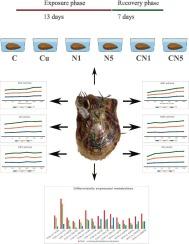Isolated and combined toxicity of PVC microplastics and copper on Pinctada fucata martensii: Immune, oxidative, and metabolomics insights
IF 4.3
3区 环境科学与生态学
Q2 BIOCHEMISTRY & MOLECULAR BIOLOGY
Comparative Biochemistry and Physiology C-toxicology & Pharmacology
Pub Date : 2025-07-29
DOI:10.1016/j.cbpc.2025.110302
引用次数: 0
Abstract
PVC microplastics (PVC MPs) and copper (Cu) are pervasive marine pollutants with significant ecological impacts. This study analyzed individual and combined effects of PVC microplastics (PVC MPs) at concentrations of 1 and 5 mg/L and copper (Cu) at concentration of 5 μg/L on immune response, oxidative balance, detoxification capacity, and hepatopancreas metabolomics in Pinctada fucata martensii. Pearl oysters were exposed to these stressors for 13 days, followed by a 7 days recovery phase. Immune enzymes: acidic phosphatase (ACP) and alkaline phosphatase (AKP); antioxidant enzymes: catalase (CAT), superoxide dismutase (SOD), and glutathione peroxidase (GPx); and detoxification enzyme: glutathione S-transferase (GST) were assessed, alongside hepatopancreas metabolomic profiling. Results showed that combined exposure (MPs + Cu) significantly elevated ACP and AKP activities compared to individual treatments, indicating enhanced immune activation. Oxidative stress biomarkers (CAT, SOD, GPx) were significantly higher in co-exposed groups, suggesting synergistic toxicity. Moreover, metabolomic analysis revealed significant alterations in key pathways, including glycerophospholipid metabolism, pentose and glucuronate interconversions, arachidonic acid metabolism, and phosphatidylinositol signaling, reflecting disruptions in membrane integrity, energy metabolism, and inflammatory responses. During recovery, enzyme activities and metabolite trends indicated partial physiological restoration, though co-exposed oysters exhibited prolonged metabolic disturbances. This study highlights the compounded toxicity of MPs and Cu, emphasizing their role in impairing bivalve health through oxidative stress, immune modulation, and metabolic disruption. The findings highlight the need for comprehensive risk assessments of marine pollutant interactions to mitigate ecological and aquacultural impacts.

聚氯乙烯微塑料和铜对fucata martensii的分离和联合毒性:免疫,氧化和代谢组学的见解。
聚氯乙烯微塑料(PVC MPs)和铜(Cu)是普遍存在的海洋污染物,具有重要的生态影响。本研究分析了浓度为1和5 mg/L的聚氯乙烯微塑料(PVC MPs)和浓度为5 μg/L的铜(Cu)对fucata martensii Pinctada免疫应答、氧化平衡、解毒能力和肝胰腺代谢组学的单独和联合影响。珍珠贝暴露在这些压力源下13 天,然后是7 天的恢复期。免疫酶:酸性磷酸酶(ACP)和碱性磷酸酶(AKP);抗氧化酶:过氧化氢酶(CAT)、超氧化物歧化酶(SOD)、谷胱甘肽过氧化物酶(GPx);和解毒酶:谷胱甘肽s -转移酶(GST)进行评估,以及肝胰腺代谢组学分析。结果显示,与单独处理相比,联合暴露(MPs + Cu)显著提高了ACP和AKP活性,表明免疫激活增强。氧化应激生物标志物(CAT, SOD, GPx)在共暴露组中显著升高,提示协同毒性。此外,代谢组学分析揭示了关键通路的显著改变,包括甘油磷脂代谢、戊糖和葡萄糖醛酸相互转化、花生四烯酸代谢和磷脂酰肌醇信号传导,反映了膜完整性、能量代谢和炎症反应的破坏。在恢复过程中,酶活性和代谢物趋势表明部分生理恢复,尽管共同暴露的牡蛎表现出长期的代谢紊乱。本研究强调了MPs和Cu的复合毒性,强调了它们通过氧化应激、免疫调节和代谢破坏损害双壳类动物健康的作用。研究结果强调需要对海洋污染物相互作用进行全面的风险评估,以减轻生态和水产养殖的影响。
本文章由计算机程序翻译,如有差异,请以英文原文为准。
求助全文
约1分钟内获得全文
求助全文
来源期刊
CiteScore
7.50
自引率
5.10%
发文量
206
审稿时长
30 days
期刊介绍:
Part C: Toxicology and Pharmacology. This journal is concerned with chemical and drug action at different levels of organization, biotransformation of xenobiotics, mechanisms of toxicity, including reactive oxygen species and carcinogenesis, endocrine disruptors, natural products chemistry, and signal transduction with a molecular approach to these fields.

 求助内容:
求助内容: 应助结果提醒方式:
应助结果提醒方式:


